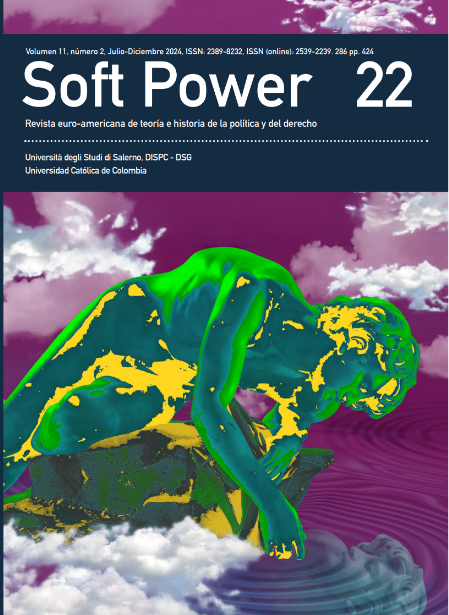
Esta obra está bajo una licencia internacional Creative Commons Atribución-NoComercial 4.0.
Al enviar los artículos para su evaluación, los autores aceptan que transfieren los derechos de publicación a Soft Power. Revista Soft Power para su publicación en cualquier medio. Con el fin de aumentar su visibilidad, los documentos se envían a bases de datos y sistemas de indización, así mismo pueden ser consultados en la página web de la Revista.Resumen
El presente artículo, extraído del libro Que faire de l’intelligence artificielle ? Petite histoire critique de la raison artificielle, ofrece una exposición didáctica y una genealogía crítica de la inteligencia artificial (IA) desde mediados del siglo XX hasta la actualidad. En la primera parte, se desvelan las hipótesis científicas fundamentales que, antes de la conferencia de Dartmouth de 1956, sustentaron la evolución de la IA simbólica (dominante hasta finales de los 80) y la IA conexionista (impulsada en las últimas dos décadas),
mientras se muestra su convergencia al concebir mente y cerebro como máquinas lógicas. En la segunda parte, se analizan aspectos sociotécnicos recientes con base enel caso de la base de datos ImageNet para ilustrar el trabajo invisible del crowdsourcing
en el entrenamiento de modelos. Al conjugar fundamentos teóricos y prácticas industriales, el texto subraya las continuidades y transformaciones que definen la industria de la IA hoy.

Citas
Cardon, D., Cointet, J.-P., & Mazières, A. (2018). La Revanche des neurones. Réseaux,5(211), 173–220. https://doi.org/10.3917/res.211.0173.
Casilli, A. A. (2019). En attendant les robots : Enquête sur le travail du clic. Seuil.Dreyfus, H. L., & Dreyfus, S. E. (1988). Making a Mind versus Modeling the Brain: ArtificialIntelligence Back at a Branchpoint. Daedalus, 117(1), 15–43.
Dupuy, J.-P. (2009). On the Origins of Cognitive Science: The Mechanization of the Mind(M. B. DeBevoise, Trans.). MIT Press.
Ekbia, H. R., & Bonnie, N. (2017). Heteromation, and Other Stories of Computing and Capitalism. The MIT Press.https://doi.org/10.7551/mitpress/10767.001.0001
Gray, M. L., & Suri, S. (2019). Ghost Work: How to Stop Silicon Valley from Building a New Global Underclass. Houghton Mifflin Harcourt.
Haugeland, J. (1989). Artificial Intelligence: The Very Idea. MIT Press. https://doi.org/10.7551/mitpress/1170.001.0001
ImageNet. (2021, March 11). About ImageNet. https://image-net.org/about.php
Levin, J. (2023). Functionalism. In E. N. Zalta & U. Nodelman (Eds.), The Stanford Encyclopedia of Philosophy (Summer 2023). Metaphysics Research Lab, Stanford University.https://plato.stanford.edu/archives/sum2023/entries/functionalism/
Markoff, J. (2012). Seeking a Better Way to Find Web Images. The New York Times.https://www.nytimes.com/2012/11/20/science/for-web-images-creating-new-technology-to-seek-and-find.html
McCulloch, W. S. (1965). Mysterium iniquitatis of sinful man aspiring into the place ofgod. In Embodiments of Mind (pp. 157–164). MIT Press. https://archive.org/details/embodimentsofmin0000mccu/page/n13/mode/
Mumford, L. (1970). The Myth of the Machine: The Pentagon of Power (Vol. 2). Harcourt
Brace Jovannich.
Newell, A., & Simon, H. A. (1976). Computer Science as Empirical Inquiry. Communications of the ACM, 19(3), 113–126. https://doi.org/10.1145/360018.360022
Pontin, J. (2007). Artificial Intelligence, With Help From the Humans. The New York Times. https://www.nytimes.com/2007/03/25/business/yourmoney/25Stream.html
Princeton University. (n.d.). *WordNet 3.1 dictionary files* [Data set]. https://wordnetcode.princeton.edu/wn3.1.dict.tar.gz
Proust, J. (1987). L’Intelligence artificielle comme philosophie. Le Débat, 47(5), 88.https://doi.org/10.3917/deba.047.0088
Taylor, A. (2018). The Automation Charade. Logic(S), (5). https://logicmag.io/failure/the-automation-charade/
Triclot, M. (2005). Penser c’est calculer : éléments pour une préhistoire de l’informatique.https://hal.science/hal-01526653/document
Turing, A. M. (1937). On Computable Numbers, With an Application to the Entscheidungsproblem.Proceedings Of The London Mathematical Society, s2-42(1), 230–265.https://doi.org/10.1112/plms/s2-42.1.230k






